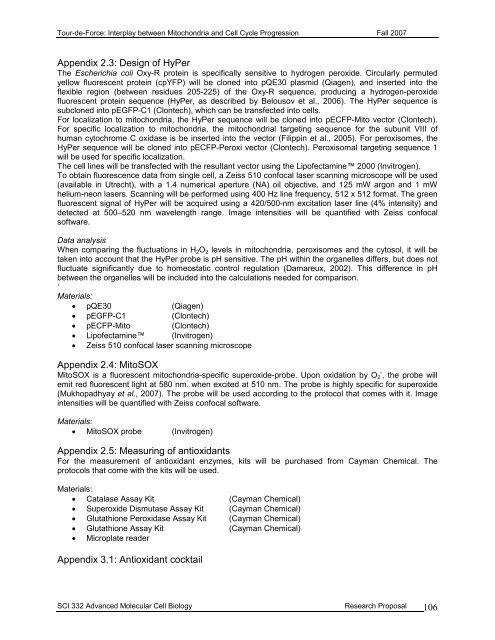Tour-de-Force
Tour-de-Force
Tour-de-Force
Create successful ePaper yourself
Turn your PDF publications into a flip-book with our unique Google optimized e-Paper software.
<strong>Tour</strong>-<strong>de</strong>-<strong>Force</strong>: Interplay between Mitochondria and Cell Cycle Progression Fall 2007Appendix 2.3: Design of HyPerThe Escherichia coli Oxy-R protein is specifically sensitive to hydrogen peroxi<strong>de</strong>. Circularly permutedyellow fluorescent protein (cpYFP) will be cloned into pQE30 plasmid (Qiagen), and inserted into theflexible region (between residues 205-225) of the Oxy-R sequence, producing a hydrogen-peroxi<strong>de</strong>fluorescent protein sequence (HyPer, as <strong>de</strong>scribed by Belousov et al., 2006). The HyPer sequence issubcloned into pEGFP-C1 (Clontech), which can be transfected into cells.For localization to mitochondria, the HyPer sequence will be cloned into pECFP-Mito vector (Clontech).For specific localization to mitochondria, the mitochondrial targeting sequence for the subunit VIII ofhuman cytochrome C oxidase is be inserted into the vector (Filippin et al., 2005). For peroxisomes, theHyPer sequence will be cloned into pECFP-Peroxi vector (Clontech). Peroxisomal targeting sequence 1will be used for specific localization.The cell lines will be transfected with the resultant vector using the Lipofectamine 2000 (Invitrogen).To obtain fluorescence data from single cell, a Zeiss 510 confocal laser scanning microscope will be used(available in Utrecht), with a 1.4 numerical aperture (NA) oil objective, and 125 mW argon and 1 mWhelium-neon lasers. Scanning will be performed using 400 Hz line frequency, 512 x 512 format. The greenfluorescent signal of HyPer will be acquired using a 420/500-nm excitation laser line (4% intensity) and<strong>de</strong>tected at 500–520 nm wavelength range. Image intensities will be quantified with Zeiss confocalsoftware.Data analysisWhen comparing the fluctuations in H 2 O 2 levels in mitochondria, peroxisomes and the cytosol, it will betaken into account that the HyPer probe is pH sensitive. The pH within the organelles differs, but does notfluctuate significantly due to homeostatic control regulation (Damareux, 2002). This difference in pHbetween the organelles will be inclu<strong>de</strong>d into the calculations nee<strong>de</strong>d for comparison.‘Materials:• pQE30 (Qiagen)• pEGFP-C1 (Clontech)• pECFP-Mito (Clontech)• Lipofectamine (Invitrogen)• Zeiss 510 confocal laser scanning microscopeAppendix 2.4: MitoSOXMitoSOX is a fluorescent mitochondria-specific superoxi<strong>de</strong>-probe. Upon oxidation by O 2 - , the probe willemit red fluorescent light at 580 nm. when excited at 510 nm. The probe is highly specific for superoxi<strong>de</strong>(Mukhopadhyay et al., 2007). The probe will be used according to the protocol that comes with it. Imageintensities will be quantified with Zeiss confocal software.Materials:• MitoSOX probe (Invitrogen)Appendix 2.5: Measuring of antioxidantsFor the measurement of antioxidant enzymes, kits will be purchased from Cayman Chemical. Theprotocols that come with the kits will be used.Materials:• Catalase Assay Kit (Cayman Chemical)• Superoxi<strong>de</strong> Dismutase Assay Kit (Cayman Chemical)• Glutathione Peroxidase Assay Kit (Cayman Chemical)• Glutathione Assay Kit (Cayman Chemical)• Microplate rea<strong>de</strong>rAppendix 3.1: Antioxidant cocktailSCI 332 Advanced Molecular Cell Biology Research Proposal 106
















